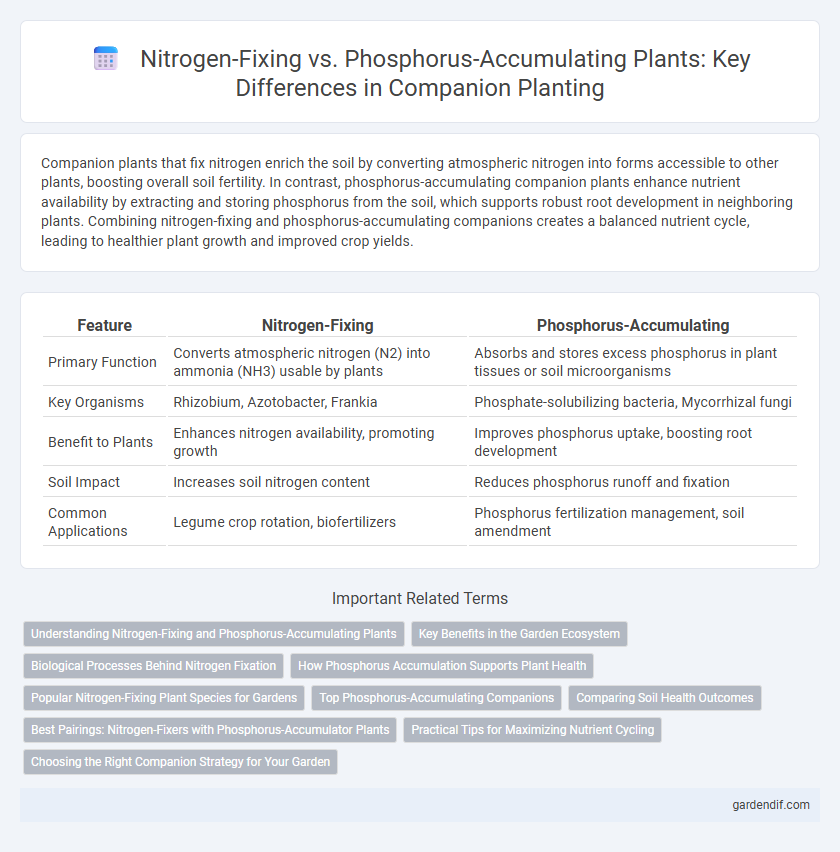
Nitrogen-fixing vs Phosphorus-accumulating Illustration
Companion plants that fix nitrogen enrich the soil by converting atmospheric nitrogen into forms accessible to other plants, boosting overall soil fertility. In contrast, phosphorus-accumulating companion plants enhance nutrient availability by extracting and storing phosphorus from the soil, which supports robust root development in neighboring plants. Combining nitrogen-fixing and phosphorus-accumulating companions creates a balanced nutrient cycle, leading to healthier plant growth and improved crop yields.
Table of Comparison
| Feature | Nitrogen-Fixing | Phosphorus-Accumulating |
|---|---|---|
| Primary Function | Converts atmospheric nitrogen (N2) into ammonia (NH3) usable by plants | Absorbs and stores excess phosphorus in plant tissues or soil microorganisms |
| Key Organisms | Rhizobium, Azotobacter, Frankia | Phosphate-solubilizing bacteria, Mycorrhizal fungi |
| Benefit to Plants | Enhances nitrogen availability, promoting growth | Improves phosphorus uptake, boosting root development |
| Soil Impact | Increases soil nitrogen content | Reduces phosphorus runoff and fixation |
| Common Applications | Legume crop rotation, biofertilizers | Phosphorus fertilization management, soil amendment |
Understanding Nitrogen-Fixing and Phosphorus-Accumulating Plants
Nitrogen-fixing plants, such as legumes, form symbiotic relationships with Rhizobium bacteria to convert atmospheric nitrogen into bioavailable forms that enrich soil fertility. Phosphorus-accumulating plants enhance phosphorus uptake and storage, often involving mycorrhizal fungi to mobilize phosphorus from soil minerals. Understanding the mechanisms behind nitrogen fixation and phosphorus accumulation is essential for optimizing companion planting strategies aimed at sustainable soil nutrient management.
Key Benefits in the Garden Ecosystem
Nitrogen-fixing plants enrich soil fertility by converting atmospheric nitrogen into forms usable by other plants, reducing the need for synthetic fertilizers in the garden ecosystem. Phosphorus-accumulating plants enhance root development and flowering by increasing phosphorus availability, improving overall plant health and productivity. Together, these companion plants create a balanced nutrient cycle that supports sustainable growth and biodiversity in the garden environment.
Biological Processes Behind Nitrogen Fixation
Nitrogen fixation is a biological process carried out by diazotrophic bacteria and archaea that convert atmospheric nitrogen (N2) into ammonia (NH3), making nitrogen accessible to plants for growth. This energy-intensive process relies on the enzyme nitrogenase, which functions under anaerobic conditions within specialized cells or root nodules in symbiotic relationships, such as those in legumes. In contrast, phosphorus accumulation involves different microbial mechanisms aimed at solubilizing and mobilizing phosphate compounds, highlighting the distinct microbial pathways supporting plant nutrient acquisition.
How Phosphorus Accumulation Supports Plant Health
Phosphorus accumulation enhances plant health by promoting root development and energy transfer within cells, essential for photosynthesis and growth. This nutrient supports the synthesis of DNA, RNA, and ATP, boosting metabolic processes and improving resistance to stress and diseases. Improved phosphorus availability also facilitates nutrient uptake efficiency, leading to stronger, more resilient plants compared to nitrogen-fixing alone.
Popular Nitrogen-Fixing Plant Species for Gardens
Popular nitrogen-fixing plant species for gardens include legumes such as clover (Trifolium spp.), alfalfa (Medicago sativa), and peas (Pisum sativum), which form symbiotic relationships with Rhizobium bacteria to convert atmospheric nitrogen into a usable form for plants. These species enhance soil fertility by increasing nitrogen availability, reducing the need for synthetic fertilizers, and supporting companion planting strategies. Incorporating nitrogen-fixing plants alongside phosphorus-accumulating species like buckwheat or comfrey optimizes nutrient cycling and promotes sustainable garden productivity.
Top Phosphorus-Accumulating Companions
Top phosphorus-accumulating companion plants such as clover, alfalfa, and comfrey enhance soil fertility by efficiently storing and recycling phosphorus, a crucial nutrient for plant growth. These companions improve phosphorus availability in the root zone, supporting surrounding crops and promoting sustainable agriculture without synthetic fertilizers. Their ability to accumulate and redistribute phosphorus makes them invaluable in companion planting systems aimed at optimizing nutrient cycling and boosting crop yields.
Comparing Soil Health Outcomes
Nitrogen-fixing plants enhance soil health by increasing nitrogen availability, promoting robust plant growth and boosting microbial activity. Phosphorus-accumulating species improve soil fertility through efficient phosphorus uptake and storage, preventing nutrient runoff and enhancing root development. Comparing soil health outcomes reveals nitrogen fixers primarily support nitrogen cycling, while phosphorus accumulators optimize phosphorus dynamics, both essential for sustainable soil management.
Best Pairings: Nitrogen-Fixers with Phosphorus-Accumulator Plants
Pairing nitrogen-fixing plants like legumes with phosphorus-accumulating species such as mycorrhizal fungi-enhanced crops improves soil nutrient balance and maximizes plant growth. Nitrogen-fixers convert atmospheric nitrogen into usable forms, enriching the soil, while phosphorus accumulators increase phosphate availability, supporting root development and energy transfer. This symbiotic relationship enhances nutrient cycling efficiency, leading to higher crop yields and sustainable soil health.
Practical Tips for Maximizing Nutrient Cycling
Maximizing nutrient cycling involves integrating nitrogen-fixing plants like legumes with phosphorus-accumulating species such as certain mycorrhizal fungi or plants that promote phosphorus solubilization. Practical tips include intercropping legumes with phosphorus-accumulating companions to enhance soil nitrogen and phosphorus availability simultaneously. Regular soil testing and targeted organic amendments improve the balance of nitrogen and phosphorus, optimizing plant uptake and overall soil fertility.
Choosing the Right Companion Strategy for Your Garden
Nitrogen-fixing plants, such as legumes, enhance soil fertility by converting atmospheric nitrogen into a usable form, promoting healthy plant growth in nitrogen-deficient soils. Phosphorus-accumulating companions, like certain mycorrhizal fungi and specialized plants, improve phosphorus availability, essential for root development and flowering. Selecting the right companion strategy depends on your garden's specific nutrient deficiencies and crop requirements to optimize soil health and plant productivity.
Nitrogen-fixing vs Phosphorus-accumulating Infographic

 gardendif.com
gardendif.com